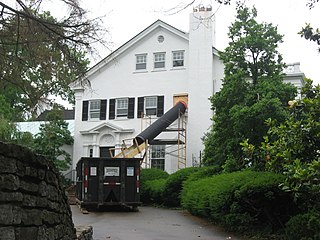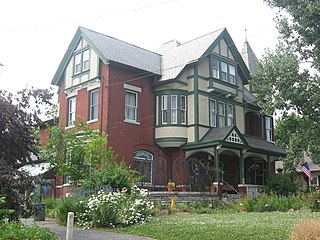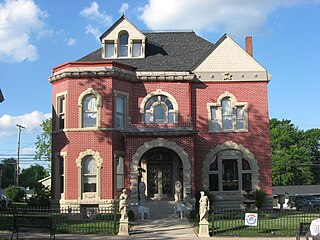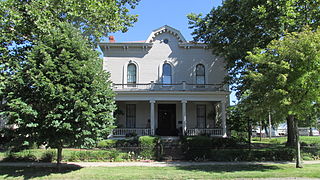Martin House | |
Front of the house | |
| Location | 6500 Beechmont Ave., Cincinnati, Ohio |
|---|---|
| Coordinates | 39°7′50″N84°21′31″W / 39.13056°N 84.35861°W Coordinates: 39°7′50″N84°21′31″W / 39.13056°N 84.35861°W |
| Area | Less than 1 acre (0.40 ha) |
| Built | 1847 |
| Architectural style | Greek Revival, Federal, Transitional |
| NRHP reference # | 79001859 [1] |
| Added to NRHP | March 21, 1979 |
The Martin House is a historic residence in the Mount Washington neighborhood of Cincinnati, Ohio, United States. Built in 1847, [1] the house is composed of two pieces: the original section, located in the back; and the front, built in 1852. [2] Between the two components, it features elements of the Greek Revival and Federal architectural styles. [1] Built of brick, [3] two stories tall, it was originally a farmhouse belonging to John C. Martin, who built his home on property owned by his father-in-law Ezekiel Rigdon, who owned nearly 100 acres (40 ha) of land on Mount Washington near the farm of one of the area's first settlers. [2]

Mount Washington is a neighborhood on the east side of Cincinnati, Ohio, United States. It is located about ten minutes east of Downtown via Columbia Parkway and Beechmont Avenue, or a slightly longer drive via Riverside Drive and Kellogg Avenue, to Salem Avenue and up Sutton Avenue or Beacon Street. As one of Cincinnati's 52 neighborhoods, Mount Washington lies within the city corporation limits, and borders the neighborhoods of California, Linwood, and the East End, as well as unincorporated Anderson Township, Hamilton County, Ohio. It is served by the 24, 30X, and 81X Metro bus routes.

Cincinnati is a major city in the U.S. state of Ohio, and is the government seat of Hamilton County. Settled in 1788, the city is located at the northern side of the confluence of the Licking and Ohio rivers, the latter of which marks the state line with Kentucky. The city drives the Cincinnati–Middletown–Wilmington combined statistical area, which had a population of 2,172,191 in the 2010 census making it Ohio's largest metropolitan area. With a population of 296,943, Cincinnati is the third-largest city in Ohio and 65th in the United States. Its metropolitan area is the fastest growing economic power in the Midwestern United States based on increase of economic output and it is the 28th-largest metropolitan statistical area in the U.S. Cincinnati is also within a day's drive of 49.70% of the United States populace.

Ohio is a Midwestern state in the Great Lakes region of the United States. Of the fifty states, it is the 34th largest by area, the seventh most populous, and the tenth most densely populated. The state's capital and largest city is Columbus.
In 1979, the Martin House was listed on the National Register of Historic Places, because of its status as a well-preserved example of the area's architecture. By this point, the house was owned by a religious organization and was also known as the "Heritage House;" [1] it received national recognition because it had almost never been altered after the construction of the front component, and few other houses in the area built at a similar time retained so many of their original components. [2]

The National Register of Historic Places (NRHP) is the United States federal government's official list of districts, sites, buildings, structures, and objects deemed worthy of preservation for their historical significance. A property listed in the National Register, or located within a National Register Historic District, may qualify for tax incentives derived from the total value of expenses incurred preserving the property.






















